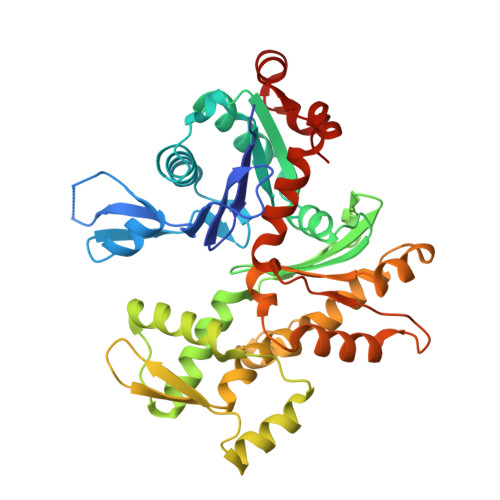Structural and biochemical studies of actin in complex with synthetic macrolide tail analogues.
Pereira, J.H., Petchprayoon, C., Hoepker, A.C., Moriarty, N.W., Fink, S.J., Cecere, G., Paterson, I., Adams, P.D., Marriott, G.(2014) ChemMedChem 9: 2286-2293
- PubMed: 25047814
- DOI: https://doi.org/10.1002/cmdc.201402150
- Primary Citation of Related Structures:
4K41, 4K42, 4K43 - PubMed Abstract:
The actin filament-binding and filament-severing activities of the aplyronine, kabiramide, and reidispongiolide families of marine macrolides are located within the hydrophobic tail region of the molecule. Two synthetic tail analogues of aplyronine C (SF-01 and GC-04) are shown to bind to G-actin with dissociation constants of (285±33) and (132±13) nM, respectively. The crystal structures of actin complexes with GC-04, SF-01, and kabiramide C reveal a conserved mode of tail binding within the cleft that forms between subdomains (SD) 1 and 3. Our studies support the view that filament severing is brought about by specific binding of the tail region to the SD1/SD3 cleft on the upper protomer, which displaces loop-D from the lower protomer on the same half-filament. With previous studies showing that the GC-04 analogue can sever actin filaments, it is argued that the shorter complex lifetime of tail analogues with F-actin would make them more effective at severing filaments compared with plasma gelsolin. Structure-based analyses are used to suggest more reactive or targetable forms of GC-04 and SF-01, which may serve to boost the capacity of the serum actin scavenging system, to generate antibody conjugates against tumor cell antigens, and to decrease sputum viscosity in children with cystic fibrosis.
- Physical Biosciences Division, Lawrence Berkeley National Laboratory, Berkeley, CA 94720 (USA).
Organizational Affiliation:




















